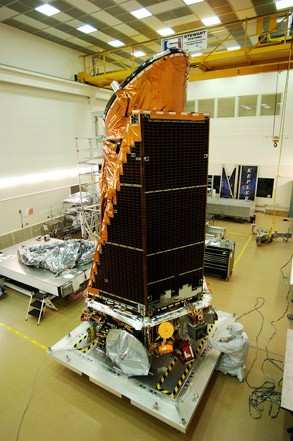Probe Scheduled For March 5 Launch
 NASA's Kepler spacecraft was ready to be moved to the launch
pad this week, and will soon begin a journey to search for worlds
that could potentially host life.
NASA's Kepler spacecraft was ready to be moved to the launch
pad this week, and will soon begin a journey to search for worlds
that could potentially host life.
Kepler is scheduled to blast into space from Cape Canaveral Air
Force Station, FL aboard a Delta II rocket on March 5 at 10:48 pm
EST. It is the first mission with the ability to find planets like
Earth -- rocky planets that orbit sun-like stars in a warm zone
where liquid water could be maintained on the surface. Liquid water
is believed to be essential for the formation of life.
"Kepler is a critical component in NASA's broader efforts to
ultimately find and study planets where Earth-like conditions may
be present," said Jon Morse, the Astrophysics Division director at
NASA Headquarters in Washington. "The planetary census Kepler takes
will be very important for understanding the frequency of
Earth-size planets in our galaxy and planning future missions that
directly detect and characterize such worlds around nearby
stars."
The mission will spend three-and-a-half years surveying more
than 100,000 sun-like stars in the Cygnus-Lyra region of our Milky
Way galaxy. It is expected to find hundreds of planets the size of
Earth and larger at various distances from their stars.
If Earth-size planets are common in the habitable zone, Kepler
could find dozens; if those planets are rare, Kepler might find
none. In the end, the mission will be humanity's first step toward
answering a question posed by the ancient Greeks: are there other
worlds like ours or are we alone?
"Finding that most stars have Earths implies that the conditions
that support the development of life could be common throughout our
galaxy," said William Borucki, Kepler's science principal
investigator at NASA's Ames Research Center at Moffett Field, CA.
"Finding few or no Earths indicates that we might be alone."
The Kepler telescope is specially designed to detect the
periodic dimming of stars that planets cause as they pass by. Some
star systems are oriented in such a way that their planets cross in
front of their stars, as seen from our Earthly point of view. As
the planets pass by, they cause their stars' light to slightly dim,
or wink.
The telescope can detect even the faintest of these winks,
registering changes in brightness of only 20 parts per million. To
achieve this resolution, Kepler will use the largest camera ever
launched into space, a 95-megapixel array of charged couple
devices, known as CCDs.
"If Kepler were to look down at a small town on Earth at night
from space, it would be able to detect the dimming of a porch light
as somebody passed in front," said James Fanson, Kepler project
manager at NASA's Jet Propulsion Laboratory in Pasadena, CA.
By staring at one large patch of sky for the duration of its
lifetime, Kepler will be able to watch planets periodically transit
their stars over multiple cycles. This will allow astronomers to
confirm the presence of planets. Earth-size planets in habitable
zones would theoretically take about a year to complete one orbit,
so Kepler will monitor those stars for at least three years to
confirm the planets' presence. Ground-based telescopes and NASA's
Hubble and Spitzer space telescopes will perform follow-up studies
on the larger planets.

"Kepler is a critical cornerstone in understanding what types of
planets are formed around other stars," said exoplanet hunter Debra
Fischer of San Francisco State University in California. "The
discoveries that emerge will be used immediately to study the
atmospheres of large, gas exoplanets with Spitzer. And the
statistics that are compiled will help us chart a course toward one
day imaging a pale blue dot like our planet, orbiting another star
in our galaxy."
 ANN's Daily Aero-Term (05.09.24): Hold Procedure
ANN's Daily Aero-Term (05.09.24): Hold Procedure ANN's Daily Aero-Term (05.06.24): Altitude Readout
ANN's Daily Aero-Term (05.06.24): Altitude Readout ANN's Daily Aero-Linx (05.06.24)
ANN's Daily Aero-Linx (05.06.24) Airborne-NextGen 05.07.24: AI-Piloted F-16, AgEagle, 1st 2 WorldView Sats
Airborne-NextGen 05.07.24: AI-Piloted F-16, AgEagle, 1st 2 WorldView Sats Aero-News: Quote of the Day (05.07.24)
Aero-News: Quote of the Day (05.07.24)




